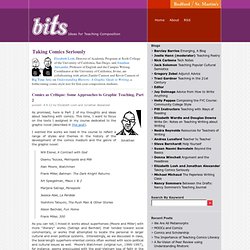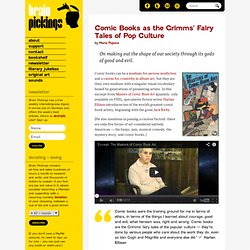

Comic.original. The Comics Grid: Journal of Comics Scholarship. The Third International Conference on Comics Conference: Comics Rock took place over Thursday 28 June and Friday 29 June 2012 at Bournemouth University, United Kingdom.

Julia Round (Bournemouth) was the main organiser. Previous versions were held at Manchester Metropolitan University. Each day of the conference covered a different theme: Comics and Education for 28 June and Comics and Multimodal Adaptation for 29 June. Comics as Critique: Some Approaches to Graphic Teaching, Part 3. Comics as Critique: Some Approaches to Graphic Teaching, Part 2. Jonathan As promised, here is Part 2 of my thoughts and ideas about teaching with comics.

This time, I want to focus on the texts I assigned in my course dedicated to the graphic novel (described in this post). I wanted the works we read in the course to reflect a range of styles and themes in the history of the development of the comics medium and the genre of the graphic novel: Will Eisner, A Contract with GodOsamu Tezuka, Metropolis and MWAlan Moore, WatchmenFrank Miller, Batman: The Dark Knight ReturnsArt Spiegelman, Maus 1 & 2Marjane Satrapi, PersepolisJessica Abel, La PerdidaYoshihiro Tatsumi, The Push Man & Other StoriesAlison Bechdel, Fun HomeFrank Miller, 300 As you can tell, I mixed in works about superheroes (Moore and Miller) with more “literary” works (Satrapi and Bechdel) that tended toward social commentary, or works that attempted to locate the personal in larger cultural and even political systems. Comics as Critique: Some Approaches to Graphic Teaching, part 1. Comic Books for Grown-Ups: 10 Masterpieces of Graphic Nonfiction.
By Kirstin Butler Seeing the world in six-panel strips, or what Allen Ginsberg has to do with the wonders of zygotes.

Who doesn’t love comic books? While infographics may be trendy today (and photography perennially sexy), there’s just something special about the work of the human hand. Good old-fashioned manual labor, literally, brings a unique richness to storytelling where words alone sometimes fall flat. We’ve put together a list of some of our favorite graphic non-fiction, excluding Maus-style memoirs — perhaps another time — since narrowing down to ten picks was tough enough. We’ve long loved authors Jack Kerouac, Allen Ginsberg, and William S. The Beats invokes the immediacy of 1940s and 50s art, music, and writing; even better, it provides political context and introduced us to an entire panoply of artists whose contributions to the era are lesser known.
How do you make 500,000 declassified documents yield up their stories? Read our full review of the SmarterComics series here. Comic Books as the Grimms' Fairy Tales of Pop Culture. By Maria Popova On making out the shape of our society through its gods of good and evil.

Comic books can be a medium for serious nonfiction and a canvas for creativity in album art, but they are their own medium with a singular visual vocabulary honed by generations of pioneering artists. In this excerpt from Masters of Comic Book Art (quaintly, only available on VHS), speculative fiction writer Harlan Ellison introduces ten of the world’s greatest comic book artists, beginning with the great Jack Kirby. (He also mentions in passing a curious factoid: there are only five forms of art considered natively American — the banjo, jazz, musical comedy, the mystery story, and comic books.) Comic books were the training ground for me in terms of ethics, in terms of the things I learned about courage, good and evil, what heroism was, right and wrong.
It’s also fascinating to hear Kirby peel the curtain on the train of curiosity behind his iconic DC Comics series New Gods: Donating = Loving. But This Book Has Pictures! The Case for Graphic Novels in an AP Classroom. Make Complex Concepts Approachable Integrating graphic novels into my curriculum has been one of the best choices I have made as a teacher of both high- and lower-level students.

These novels can make a difficult subject interesting and relatable. I have seen many students with no previously expressed interest in language and literature excel in the analysis of a graphic novel. The graphic novel is also an excellent way to teach complex concepts to higher-level students and to introduce them to an important postmodern genre. The visual world has had increasing impact on our students' lives, and this is a way to connect to untapped portions of their minds. I have taught the graphic novel primarily with Art Spiegelman's MAUS: A Survivor's Tale (volumes 1 and 2) through a Holocaust research unit for advanced tenth-grade students. There are many ways use graphic novels in your classroom. Students also benefit from other, more general vocabulary for visual analysis. 1. 2. 3. 4. Lisa S. Comics. Reading A Graphic Novel.